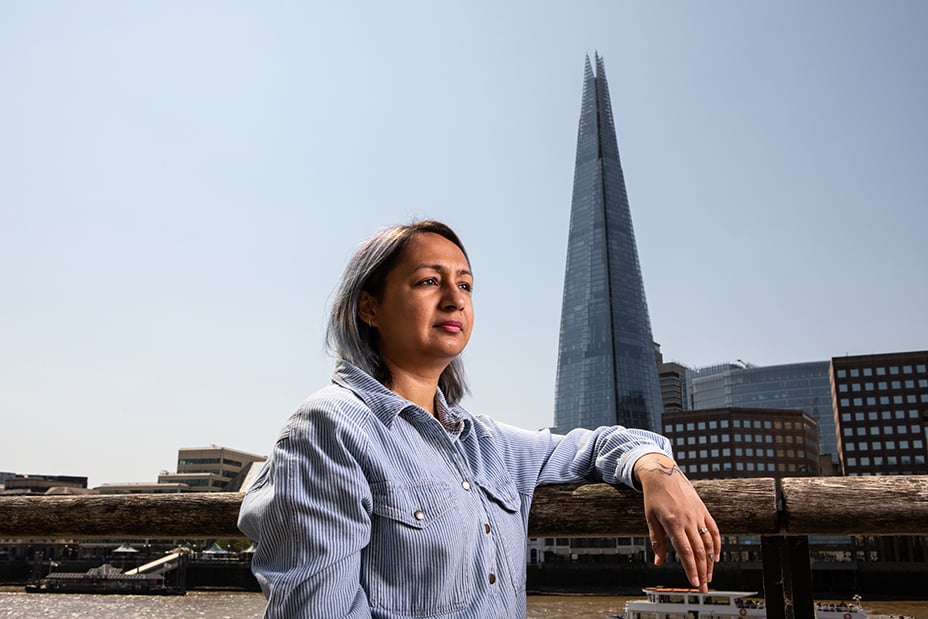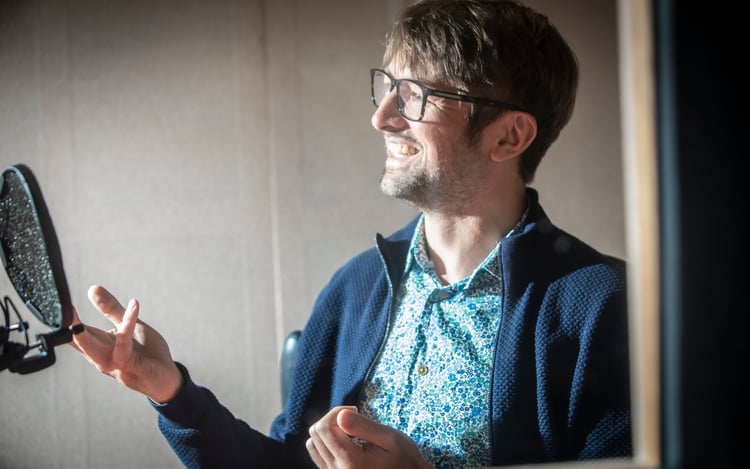
Author Roma Agrawal photographed by Antonio Olmos
Structural engineer Roma Agrawal arrives at the bank of the Thames, opposite the iconic Shard skyscraper, whose foundations and spire she helped design. The 72-storey building is the UK’s tallest. But Agrawal’s attention is fixed on a much smaller object that she removes from her handbag: a nail that she forged herself.
As she slides it between her fingers, she explains how little the object has changed since its invention 6,000 years ago. And, at the same time, how much it has changed the world.
“Nails cost almost nothing now, and they’re just rolling around in our drawers. But if I take you back some 400 years to Colonial America, nails were incredibly precious,” she says. “They were so expensive because Britain banned the export of nails to its colonies because it didn’t want the ones in the UK going anywhere else.”
The UK’s voracious appetite for nails – which artisans used in everything from constructing ships, to fastening roof boards to buildings, to fixing shoes to horses – ultimately led the US to develop its own nail industry.
American entrepreneurs built factories containing machines that could mass-produce nails at a rate of 100 units a minute by the early 1800s. Soon after, the US became a global competitor to the UK in the sector, teaching a valuable lesson about the risks of protectionism.
Early interest
Starting small to tell a bigger story is the central point of Agrawal's book, Nuts & Bolts: Seven Small Inventions that Changed the World. It charts the history of the nail, string, wheel, magnet, spring, lens and pump.
Agrawal’s fascination with engineering began when, as a curious child, she broke apart crayons and ballpoint pens to see how they worked. She spent her early years in India, where teachers give great weight to science, technology, engineering and mathematics (STEM) subjects. So it wasn’t odd that she was, in her own words, “a maths and physics nerd”.
She became aware that others perceived her passion for the subjects as unusual when she moved to the UK to study for her A-levels and later to take a Physics degree at Oxford University. And when she subsequently specialised in engineering, she gained a greater awareness of being in the minority – to this day, only 15 per cent of engineers in the UK are female, although the figure is higher in the Middle East and Asia.

Journalist Jane Wakefield talks to Roma in London
This prompts the question: what would she change to improve the balance? She answers without hesitation. “The culture of the workplace.”
“I would go on construction sites as a young engineer, and there would still be pictures of naked women on the walls. There was a narrative for a while that we, as minorities, needed to adapt to fit in. That we, as women or as people of colour, need to adapt to the workplace to thrive. Now we’re saying, hold on a second, why can’t the workplace culture be such that all our differences are embraced and that we can all thrive?”
Stone Age string
Writing Nuts & Bolts challenged Agrawal to question some of her own preconceptions as she delved into the origins of her selected inventions.
“String was probably the most surprising,” she says. “We don’t often think of string as being an engineering invention or a piece of innovation, but it has developed over hundreds of thousands of years from something we used to make clothes into something that now holds up bridges.”
By chance, archaeologists made a remarkable and unexpected discovery that string dates back to the Neanderthals while Agrawal was researching the subject.
“They only found evidence of this three years ago while I was writing my book,” she explains. “They found this tiny little piece of string in France that Neanderthals had created by twisting fibres from the bark of a tree.”
String’s Stone Age inventor remains unknown, but Agrawal uses her book to name and celebrate some of science and engineering’s other unsung heroes. From Stephanie Kwolek, who invented the bulletproof vest material Kevlar, to Josephine Cochran, who patented one of the first workable dishwashers back in 1886, to Indian scientist Jagadish Chandra Bose, a pioneer in wireless technology.
So would the world look very different if there had been more female engineers or those from more diverse backgrounds? Agrawal points out that many men had tried and failed before Josephine Cochran cracked the dishwasher.
“I always conjecture that is because men never wash dishes,” she laughs.
But on a more serious note, she is emphatic that all marginal communities need a voice in engineering. “Otherwise, you are not going to get the best solutions that work for everyone.”
Focusing on the lens
The most personal part of Agrawal’s book is the chapter on the lens, which begins with a letter to her daughter who was born via IVF. “I got to see you before you went into my body,” she writes. “You wouldn’t exist without a seemingly simple little curved piece of glass.”
She explains that the lens was part of a microscope that had let scientists create the embryo that became her child.
“Microscopes became a little bit of a fascination. And I basically tried to keep breaking all these complex pieces of technology down to the elements.
“By breaking things down, we can understand them better.”
And that is essentially the message of her book. By exploring the origins and impacts of seven small but critical inventions, we can better appreciate how they helped shape the world over centuries, sometimes millennia, and acknowledge the human endeavour involved.
Risk factors
The views expressed should not be considered as advice or a recommendation to buy, sell or hold a particular investment. They reflect opinion and should not be taken as statements of fact nor should any reliance be placed on them when making investment decisions.
This communication was produced and approved in April 2023 and has not been updated subsequently. It represents views held at the time of writing and may not reflect current thinking.
The risk of investing in private companies could be greater as these assets may be more difficult to sell, so changes in their prices may be greater.
Potential for Profit and Loss
All investment strategies have the potential for profit and loss, your or your clients’ capital may be at risk. Past performance is not a guide to future returns.
This communication contains information on investments which does not constitute independent research. Accordingly, it is not subject to the protections afforded to independent research, but is classified as advertising under Art 68 of the Financial Services Act (‘FinSA’) and Baillie Gifford and its staff may have dealt in the investments concerned.
All information is sourced from Baillie Gifford & Co and is current unless otherwise stated.
The images used in this communication are for illustrative purposes only.
Important information
Baillie Gifford & Co and Baillie Gifford & Co Limited are authorised and regulated by the Financial Conduct Authority (FCA). Baillie Gifford & Co Limited is an Authorised Corporate Director of OEICs.
Baillie Gifford Overseas Limited provides investment management and advisory services to non-UK Professional/Institutional clients only. Baillie Gifford Overseas Limited is wholly owned by Baillie Gifford & Co. Baillie Gifford & Co and Baillie Gifford Overseas Limited are authorised and regulated by the FCA in the UK.
Persons resident or domiciled outside the UK should consult with their professional advisers as to whether they require any governmental or other consents in order to enable them to invest, and with their tax advisers for advice relevant to their own particular circumstances.
Financial intermediaries
This communication is suitable for use of financial intermediaries. Financial intermediaries are solely responsible for any further distribution and Baillie Gifford takes no responsibility for the reliance on this document by any other person who did not receive this document directly from Baillie Gifford.
Europe
Baillie Gifford Investment Management (Europe) Limited provides investment management and advisory services to European (excluding UK) clients. It was incorporated in Ireland in May 2018. Baillie Gifford Investment Management (Europe) Limited is authorised by the Central Bank of Ireland as an AIFM under the AIFM Regulations and as a UCITS management company under the UCITS Regulation. Baillie Gifford Investment Management (Europe) Limited is also authorised in accordance with Regulation 7 of the AIFM Regulations, to provide management of portfolios of investments, including Individual Portfolio Management (‘IPM’) and Non-Core Services. Baillie Gifford Investment Management (Europe) Limited has been appointed as UCITS management company to the following UCITS umbrella company; Baillie Gifford Worldwide Funds plc. Through passporting it has established Baillie Gifford Investment Management (Europe) Limited (Frankfurt Branch) to market its investment management and advisory services and distribute Baillie Gifford Worldwide Funds plc in Germany. Similarly, it has established Baillie Gifford Investment Management (Europe) Limited (Amsterdam Branch) to market its investment management and advisory services and distribute Baillie Gifford Worldwide Funds plc in The Netherlands. Baillie Gifford Investment Management (Europe) Limited also has a representative office in Zurich, Switzerland pursuant to Art. 58 of the Federal Act on Financial Institutions (‘FinIA’). The representative office is authorised by the Swiss Financial Market Supervisory Authority (FINMA). The representative office does not constitute a branch and therefore does not have authority to commit Baillie Gifford Investment Management (Europe) Limited. Baillie Gifford Investment Management (Europe) Limited is a wholly owned subsidiary of Baillie Gifford Overseas Limited, which is wholly owned by Baillie Gifford & Co. Baillie Gifford Overseas Limited and Baillie Gifford & Co are authorised and regulated in the UK by the Financial Conduct Authority.
China
Baillie Gifford Investment Management (Shanghai) Limited 柏基投资管理(上海)有限公司(‘BGIMS’) is wholly owned by Baillie Gifford Overseas Limited and may provide investment research to the Baillie Gifford Group pursuant to applicable laws. BGIMS is incorporated in Shanghai in the People’s Republic of China (‘PRC’) as a wholly foreign-owned limited liability company with a unified social credit code of 91310000MA1FL6KQ30. BGIMS is a registered Private Fund Manager with the Asset Management Association of China (‘AMAC’) and manages private security investment fund in the PRC, with a registration code of P1071226.
Baillie Gifford Overseas Investment Fund Management (Shanghai) Limited柏基海外投资基金管理(上海)有限公司(‘BGQS’) is a wholly owned subsidiary of BGIMS incorporated in Shanghai as a limited liability company with its unified social credit code of 91310000MA1FL7JFXQ. BGQS is a registered Private Fund Manager with AMAC with a registration code of P1071708. BGQS has been approved by Shanghai Municipal Financial Regulatory Bureau for the Qualified Domestic Limited Partners (QDLP) Pilot Program, under which it may raise funds from PRC investors for making overseas investments.
Hong Kong
Baillie Gifford Asia (Hong Kong) Limited 柏基亞洲(香港)有限公司 is wholly owned by Baillie Gifford Overseas Limited and holds a Type 1 and a Type 2 license from the Securities & Futures Commission of Hong Kong to market and distribute Baillie Gifford’s range of collective investment schemes to professional investors in Hong Kong. Baillie Gifford Asia (Hong Kong) Limited
柏基亞洲(香港)有限公司 can be contacted at Suites 2713–2715, Two International Finance Centre, 8 Finance Street, Central, Hong Kong. Telephone +852 3756 5700.
South Korea
Baillie Gifford Overseas Limited is licensed with the Financial Services Commission in South Korea as a cross border Discretionary Investment Manager and Non-discretionary Investment Adviser.
Japan
Mitsubishi UFJ Baillie Gifford Asset Management Limited (‘MUBGAM’) is a joint venture company between Mitsubishi UFJ Trust & Banking Corporation and Baillie Gifford Overseas Limited. MUBGAM is authorised and regulated by the Financial Conduct Authority.
Australia
Baillie Gifford Overseas Limited (ARBN 118 567 178) is registered as a foreign company under the Corporations Act 2001 (Cth) and holds Foreign Australian Financial Services Licence No 528911. This material is provided to you on the basis that you are a ‘wholesale client’ within the meaning of section 761G of the Corporations Act 2001 (Cth) (‘Corporations Act’). Please advise Baillie Gifford Overseas Limited immediately if you are not a wholesale client. In no circumstances may this material be made available to a ‘retail client’ within the meaning of section 761G of the Corporations Act.
This material contains general information only. It does not take into account any person’s objectives, financial situation or needs.
South Africa
Baillie Gifford Overseas Limited is registered as a Foreign Financial Services Provider with the Financial Sector Conduct Authority in South Africa.
North America
Baillie Gifford International LLC is wholly owned by Baillie Gifford Overseas Limited; it was formed in Delaware in 2005 and is registered with the SEC. It is the legal entity through which Baillie Gifford Overseas Limited provides client service and marketing functions in North America. Baillie Gifford Overseas Limited is registered with the SEC in the United States of America.
The Manager is not resident in Canada, its head office and principal place of business is in Edinburgh, Scotland. Baillie Gifford Overseas Limited is regulated in Canada as a portfolio manager and exempt market dealer with the Ontario Securities Commission ('OSC'). Its portfolio manager licence is currently passported into Alberta, Quebec, Saskatchewan, Manitoba and Newfoundland & Labrador whereas the exempt market dealer licence is passported across all Canadian provinces and territories. Baillie Gifford International LLC is regulated by the OSC as an exempt market and its licence is passported across all Canadian provinces and territories. Baillie Gifford Investment Management (Europe) Limited (‘BGE’) relies on the International Investment Fund Manager Exemption in the provinces of Ontario and Quebec.
Israel
Baillie Gifford Overseas is not licensed under Israel’s Regulation of Investment Advising, Investment Marketing and Portfolio Management Law, 5755–1995 (the Advice Law) and does not carry insurance pursuant to the Advice Law. This material is only intended for those categories of Israeli residents who are qualified clients listed on the First Addendum to the Advice Law.
10031025




